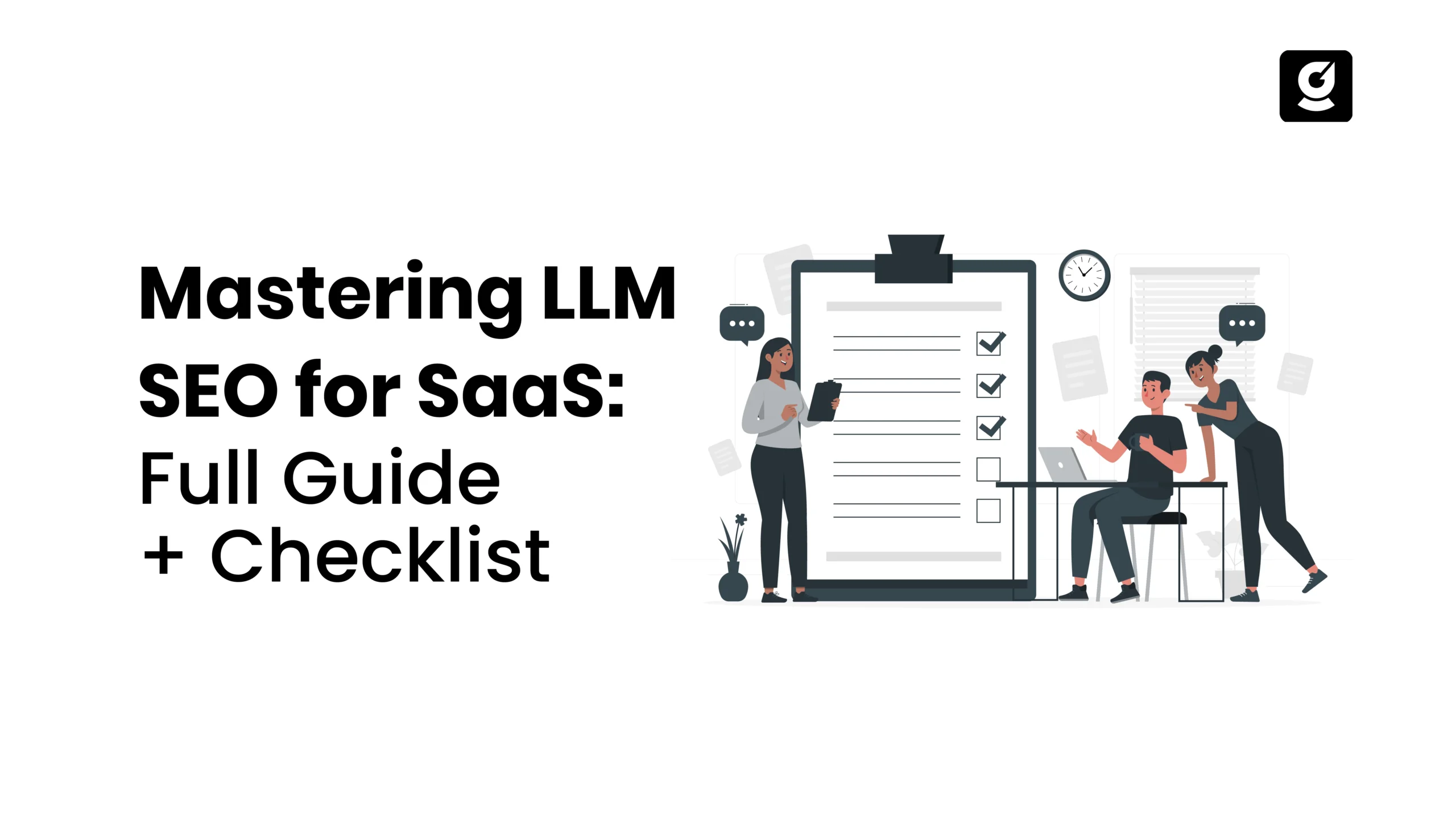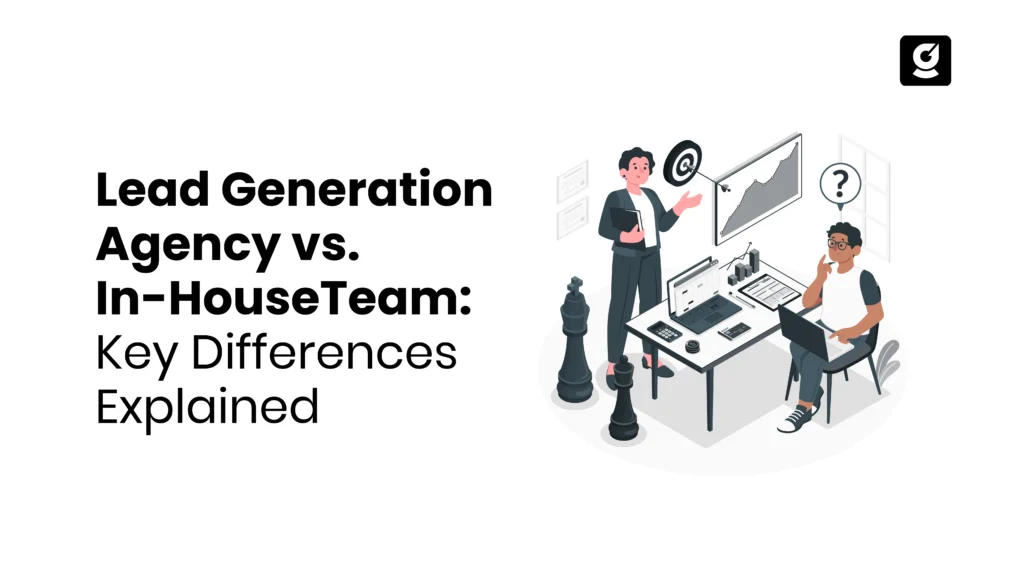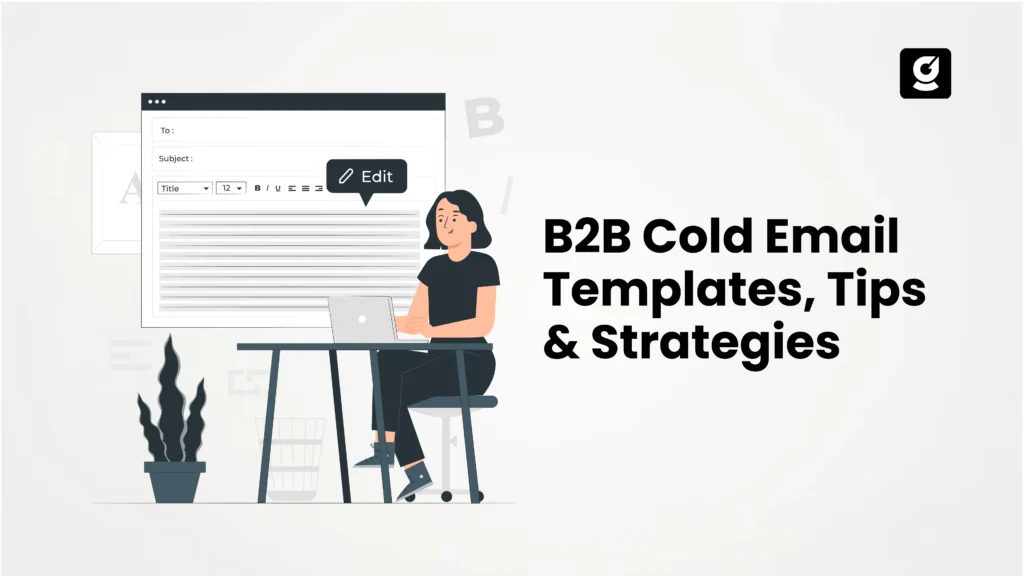At our agency, we’ve seen firsthand how Large Language Models (LLMs) like ChatGPT, Copilot, and Perplexity are transforming the way users search, engage with content, and make purchasing decisions, especially in the SaaS space.
For SaaS SEO agencies, this shift isn’t just a tech trend; it’s a new frontier in SEO. The rise of AI-driven search means that your brand’s visibility now depends on how well your content is understood, not just by search engines, but also by Generative AI, AEO strategies, and GEO approaches.
These new methodologies focus on optimizing content for both machine-driven processes and expert insights. That requires a SaaS strategy that is future-ready and focused on content and optimization.
It’s built to help SaaS brands navigate this change. Our goal is to demonstrate how to align your strategy with the behavior of Large Language Model LLM SEO, ensuring your content remains discoverable, relevant, and competitive.
What’s Inside:
We’ll break down how LLMs are shaping modern search, why optimizing for them is now an SEO imperative, and how you can leverage these insights to drive qualified traffic and leads for your SaaS startup.
What is LLM SEO?
LLM SEO uses large language models (LLMs) as part of the process of optimizing web content and descriptions for search engines. These AI models understand and respond to natural language generated by businesses for potential customers, driving traffic to their sites and helping them rank well on search engines.
Integrating AEO ensures that the content not only aligns with the algorithms but also with expert knowledge, creating authoritative content that resonates with both AI and human reviewers.
Traditional SEO vs. LLM SEO
| Traditional SEO | LLM SEO | |
| Ranking | SERP position, domain authority, link-building | Relevance in training data, citations in AI answers |
| Keywords | Targeted by usage and volume | Targeted by context, semantics, and question-based phrases |
| Updates | Frequent fresh content helps rank | AI training cutoffs matter; real-time retrieval is still developing |
| Structure | Headings (H1-H3), meta tags, alt text | Clear sections, definitions, bullet points for easy parsing |
| Linking | External + internal links boost rank | Trusted references, consistent brand mentions across multiple sites |
| Content Depth | Enough for user queries though sometimes broad | Must be thorough and context-rich so LLMs can quote or paraphrase well |
Why LLM Optimization is Crucial for SaaS SEO
For B2B SaaS startups or businesses, competition for organic traffic is intense. LLM optimization enables SaaS companies to create personalized, contextually relevant content, improving rankings and traffic. By understanding and predicting user intent, LLMs ensure content meets both search engine and user expectations, giving SaaS companies a competitive edge.
Here’s why LLM optimization is so important for SaaS SEO:
- Better Traffic & Visibility:
LLM SEO helps businesses target not just the right keywords but also related phrases and terms. This broadens the reach of your content, making it more likely to appear in relevant search results.
- Improved Engagement:
With LLMs, content can better align with user queries, offering more precise and helpful answers. This means users are more likely to stay on your site and engage with your content.
- Increased Content Relevance:
By understanding what users actually want, LLMs help create content that’s more aligned with their needs, making it more likely to rank well and resonate with readers.
- Better User Experience:
LLMs help businesses organize content into clear topics and sections, making it easier for users to find what they’re looking for. This approach improves both the usability and SEO of the content.
- Focusing on User Intent:
LLMs are good at identifying the intent behind user searches. By understanding why someone is searching for something, businesses can create content that directly answers those needs, improving both engagement and the chance of converting visitors into customers.
How Large Language Models SEO Works
LLMs function by processing vast amounts of text data and learning. It enables them to provide the most relevant words, phrases, and structures for use when creating content that responds to user search queries.
LLMs utilize the context of a search query, enhanced through AEO techniques, ensuring content is optimized to meet expert expectations. This approach provides not only contextually relevant responses but also aligns with GEO, enabling your content to evolve in response to dynamic search behaviors.
If you optimize for meaning and relevance rather than keywords and phrases, it will differentiate your brand or services from the competition. Here is how LLMs enhance the categories of SEO:
- Keyword Targeting: LLMs take user queries and not only target exact keywords but also terms and phrases within the same semantic domain. It enables targeting a wider range of relevant keywords, increasing the potential for content visibility across multiple search intents.
- Content Structuring: LLMs will help structure content in a manner that makes it more consumable by users and search engines. They provide suggestions for optimized headings, subheadings, and even meta tags, enabling efficiency in both consumption and SEO.
- Semantic Search: Large Language Models (LLMs) are effective in optimizing for semantic search. They can comprehend the background of a user’s query and optimize content to accurately answer it, resulting in the content having a higher chance of appearing in the search results for other similar but distinct queries.
With LLM SEO, businesses can craft more intelligent and user-centered content that meets the ever-evolving demands of search engine algorithms, giving them a distinct advantage in driving organic traffic.
Key LLM Optimization Strategies for SaaS SEO
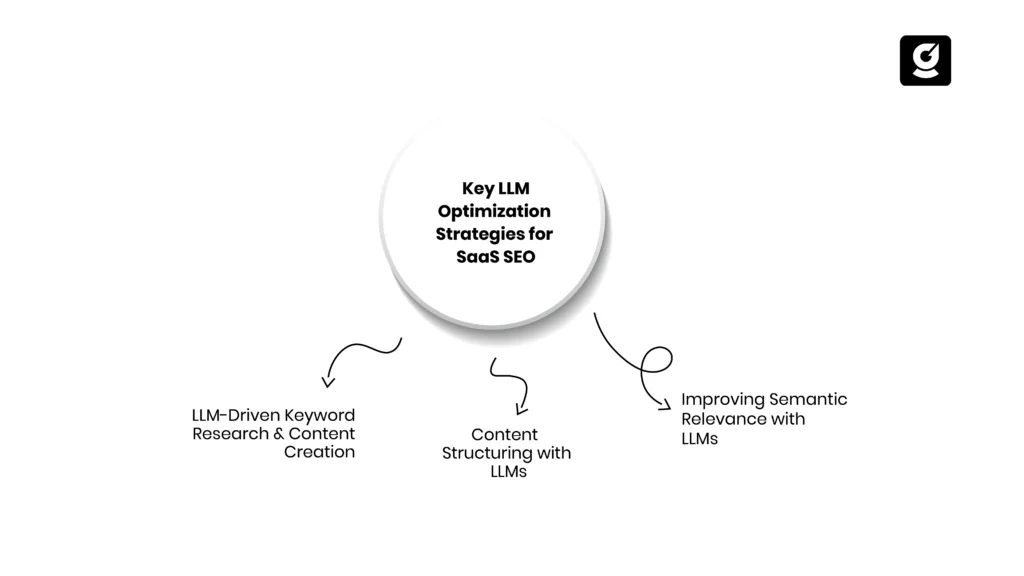
To fully benefit from LLM-powered SEO, SaaS companies must implement strategies that align with user intent, content structure, and search semantics.
1. LLM-Driven Keyword Research & Content Creation
- Identifying High-Intent Keywords: LLM SEO enables SaaS businesses to pinpoint high-value keywords that align with their target audience’s needs, ensuring content is relevant to what users are actively searching for.
- Optimizing Content Clusters: By utilizing large language models (LLMs), businesses can create topic clusters that enhance the depth and breadth of content, ensuring it covers a range of related subtopics and improves overall SEO performance.
- Targeting User Intent: LLM-driven keyword research enables companies to focus on the specific intent behind user searches, allowing them to create content that answers questions in a more personalized and relevant way.
2. Content Structuring with LLMs
- Better Organization of Content: LLM optimization enables you to present and tag content with clear headings, subheadings, and logical sequences, making it easier for both users and search engines to navigate and understand.
- Effective Use of Schema Markup: LLMs can suggest how to utilize schema markup properly, enabling search engines to identify and contextualize content more effectively, thereby ranking it accordingly.
- Best Practices for SaaS Sites: By using LLMs to organize content around user needs and search trends, SEO for SaaS organizations can make sure that the offered content utilizes the best ‘readability’ and‘ SEO’ strategies to enhance user engagement.
3. Improving Semantic Relevance with LLMs
- Understanding User Search Intent: Large Language Models SEO provides insight into the user’s search, making sure that content covers the meaning of queries beyond just keywords.
- Optimizing for Semantic Search: LLM SEO Enhances Semantic Matching of SaaS Content. By using LLM optimization, the content will answer the user’s questions explicitly while matching (albeit paraphrased) user intent.
- Increasing Content Accuracy: By focusing on relevance through semantics, LLMs enable SaaS companies to provide not only a large number of keywords but also ensure accuracy in what the user expects, thereby enhancing engagement and ultimately improving ranking.
How to Get Started with LLM-Optimized SaaS SEO

Begin by building a clear foundation—understand how Large Language Models (LLMs) enhance SEO and integrate them effectively into your SaaS marketing approach.
Implementing Large Language Models SEO in Your SaaS Strategy
- Identify Key SEO Areas for Optimization: Start by assessing your current SEO strategy. Pinpoint areas where LLM optimization can have the most impact, such as content creation, keyword targeting, and semantic search.
- Create High-Quality, Intent-Focused Content: Utilize Large Language Models (LLMs) to generate content that precisely answers user queries. Focus on addressing user intent and structuring content to provide value.
- Optimize Technical SEO Elements: Apply LLMs to enhance your technical SEO, including meta tags, schema markup, and internal linking, to improve search visibility across your website.
- Leverage the Right Tools: Utilize a platform like growth.cx to streamline and automate the LLM-powered SEO process. growth.cx helps SaaS businesses implement SEO strategies efficiently, driving both traffic and user engagement.
LLM Journey Results
How Quickly Businesses Can See Results
Most SaaS businesses begin seeing early movement in keyword rankings and improved content relevance soon after implementing LLM SEO. Over the following months, these gains compound, resulting in sustained organic traffic growth, stronger engagement, and higher conversions.
How Quickly Businesses Can See Results
- Short-Term Impact: SaaS businesses can expect to see noticeable improvements within a few weeks of implementing LLM SEO strategies, particularly in keyword rankings and content relevancy.
- Long-Term Gains: With consistent application, LLM optimization can help achieve sustained growth in organic traffic and rankings over several months, providing a strong competitive advantage.
- Measurable Results: By monitoring key metrics such as organic search traffic, engagement rates, and conversion rates, businesses can quickly measure the success of their LLM-powered SEO efforts.
growth.cx is a full-service B2B SaaS Marketing Agency with a specialization in helping SaaS startups grow. They offer a comprehensive range of services, including AI SEO, SaaS SEO, content marketing, performance marketing, cold emailing, and more.
The agency’s LLM optimization strategies enhance content relevance and keyword targeting, aligning with user intent and search algorithms. This platform enhances search rankings and organic traffic through Large Language Model (LLM) SEO.
As a growth marketing agency, its approach is driven by the business needs of each SaaS client and informed by the agency’s extensive experience and expertise in growth. Each client gets their strategy.
For more information, visit growth.cx.
growth.cx AI SEO Case Study Example
Visitor Management for Transport – A content-led campaign for Visitly positioned the brand at the top of search results for high-intent keywords like “visitor management for transport.” The strategy combined keyword-optimized content with structured information architecture, driving authority in a competitive niche.
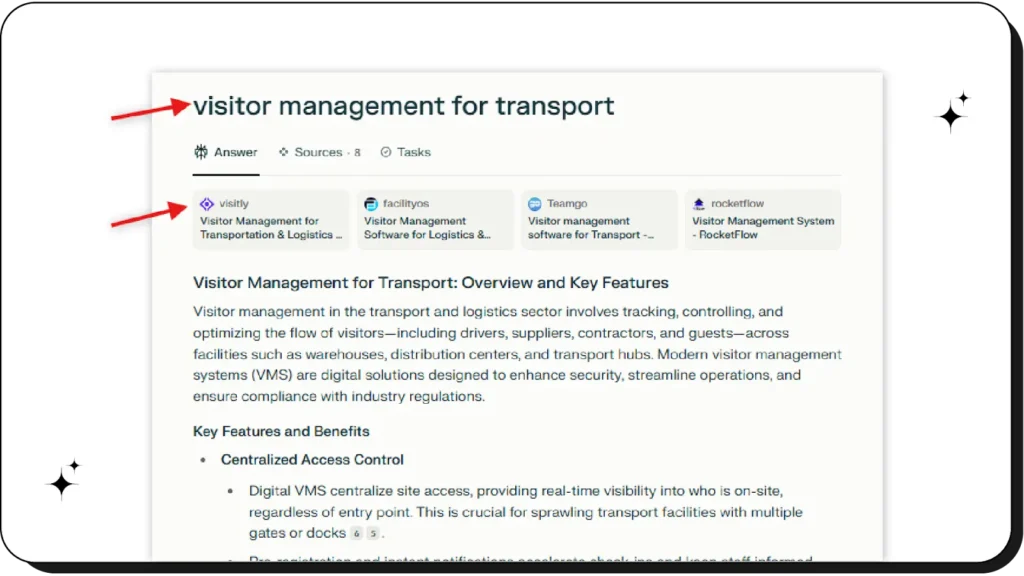
Pipedrive Texting Integration – For HelloSend, a focused SEO approach ensured top-ranking placements for transactional queries such as “Pipedrive texting integration.” This resulted in increased click-throughs from qualified prospects actively searching for CRM-integrated SMS solutions.

These are just two snapshots of the many case studies where smart SEO and content execution delivered measurable results.
You can explore more success stories in our growth.cx case study page.
Common Mistakes to Avoid in LLM SEO
- Quality Over Quantity: While LLMs can produce content at scale, prioritizing quality over quantity will ultimately provide stronger SEO results in the long run. High-quality, relevant content will always yield better results, as it is more effective than low-quality, generic, and superficial content.
- Human Expertise Matters: LLM Optimization Should Enhance, Not Supplant, Human Expertise. The combination of someone’s existing knowledge and expertise with LLM-produced content will ensure relevance and authenticity, which is significantly more appealing and practical to both audiences and search engines.
- The Dark Side of Automation: When relying entirely on AI-based content, it can either yield keyword stuffing or provide surface-level responses. Having a varied source of content and ensuring your content truly adds value to readers while still adhering to your SEO best practices is key before calling it a day.
- LLM Technical SEO: LLMs will also enhance the technical aspects of SEO, including schema markup, URL structure, and content indexing. If you only look at one part of the puzzle, such as content creation, you could miss aspects of the overall SEO optimization.
Missed Opportunities When Only Focusing on One Aspect of SEO
- Expanding Reach with a Unified Strategy: By integrating LLMs into various SEO elements, SaaS businesses can increase their reach, enhance content discoverability, and create a more engaging user experience across all touchpoints.
- SEO is a Holistic Effort: Limiting LLM optimization to just content or keyword research can cause SaaS businesses to miss out on valuable traffic and ranking opportunities. A holistic approach, considering all aspects of SEO, delivers the best results.
How to Implement LLM SEO From Scratch
This table outlines the key actions required to successfully implement LLM SEO on your site, from auditing existing content to scaling your efforts.
| Step | What to Do | Example |
| Audit Your Existing Content for AI Usability | Ensure clarity and structure for easy AI digestion. | Reformatting blog posts with headings increased featured snippets. |
| Restructure Site Architecture | Organize content into clusters for better navigation. | The hub-and-spoke model improved session duration by 30%. |
| Write Answer Blocks | Add TL;DR summaries and FAQs to improve accessibility. | TL;DR sections reduced bounce rates by 15%. |
| Build E-E-A-T | Show expertise and trustworthiness through author bios and backlinks. | Guest posts boosted the domain authority by 10 points. |
| Add Schema and Metadata | Implement schema markup for content clarity. | The FAQ schema increased CTR by 20% |
| Launch LLM SEO Content | Create content, such as reports and comparisons, to enhance AI visibility. | Benchmarking report led to a 35% traffic increase. |
| Track and Scale | Monitor performance and scale successful strategies. | Performance tweaks resulted in sustained traffic growth. |
The Ultimate LLM SEO Checklist for SaaS Companies
Follow this step-by-step checklist to fully integrate LLM-driven SEO into your SaaS strategy and maximize long-term search performance.
1. Structuring Content to Align with LLM Requirements
When working with LLMs, it is crucial to understand how content structure affects the way these models interpret and select information.
By organizing your content with consistency and clarity, you ensure that both LLMs and users can easily digest the material.
Key Structuring Tips:
- Use Hierarchical Headings (H2, H3, H4, etc.): LLMs tend to perform better when content is structured with clear heading levels. This makes it easier for the model to extract the most relevant information. A standard structure might look like this:
- H2: Introduction to SaaS SEO
- H3: Key Concepts of SaaS SEO
- H4: Traditional vs. LLM SEO
- H5: Advanced SEO Strategies
- Subheadings and Lists: Subheadings should break down each concept or strategy into smaller, digestible pieces. This approach is critical for LLMs, as they rely on clear cues to identify key points. Lists (whether bulleted or numbered) help LLMs process information logically.
| Example:When discussing SEO strategies, break each strategy into a different section heading and use proper bullet points to highlight quick action items. Instead of a lengthy paragraph, use:H3: On-Page OptimizationKeyword researchContent qualityInternal linking |
| Why It Works:The use of logical, consistent heading structures and organized lists allows LLMs to interpret the information as distinct entities. This ensures that the content will be accurately identified, summarized, and utilized by these models. |
2. Factual Content for Increased Trustworthiness
LLMs prioritize information that is fact-based, verifiable, and easily supported by reputable sources. This is why content that includes well-sourced facts, figures, and case studies is more likely to be selected by LLMs for inclusion in search results.
How to Incorporate Factual Information:
- Link to Reputable Sources: Always include external links to authoritative websites that back your claims. If you mention a statistic, provide the source so LLMs can evaluate its credibility.
- Use Clear, Verifiable Statements: Avoid ambiguity and ensure that every statement you make can be traced to a reliable, factual origin. Instead of “SEO can improve business results,” state “A 2022 study by [X] found that companies with strong SEO practices are 30% more likely to increase revenue.”
- Data-Driven Insights: Include data points from original research, surveys, or case studies. Providing unique data gives your content more weight, and LLMs tend to value content that is original and factually sound.
| Example: “According to (X studies) businesses that optimize for user intent in their SEO strategies see a 40% higher conversion rate.” |
| Why It Works: Fact-checkable content not only adds value for your readers but also signals reliability to LLMs, making it more likely that the information will be used in relevant search results. |
3. Maintain Consistency Across All Digital Platforms
LLMs rely on contextual and consistent brand references across websites and digital properties to assess the authority and relevance of your content. If your brand’s details, product information, and core messages vary across channels, LLMs may struggle to trust or properly categorize your content.
What to Do:
- Standardize Product Names and Descriptions: Ensure that your product descriptions and company details are consistent across your website, social media, and third-party platforms. Inconsistent naming can confuse the LLM, reducing your visibility.
- Repeat Key Brand Messages: Your core brand messaging should be the same, whether you’re discussing it in blog posts, social media updates, or customer reviews. For instance, if your SaaS tool focuses on “customer retention,” use the term consistently across all your content.
| Example:If your product is called “GrowthPro,” ensure that the term is used uniformly across blog posts, whitepapers, product pages, and social media platforms. Variations like “Growth Pro” or “GrowthPro SaaS” could confuse the LLM. |
| Why It Works:By maintaining consistent branding and messaging, you establish a strong, unified presence that LLMs can easily recognize and trust. |
4. Optimize for Topic Relevance Over Backlink Quantity
In traditional SEO, backlinks were a key factor in ranking. However, LLMs prioritize content relevance and semantic search, which means how well the content answers a query and its alignment with the user’s intent, rather than just the number of inbound links.
How to Build Content Relevance:
- Focus on Comprehensive Coverage: Rather than writing isolated articles, aim to build content clusters. This means grouping related content around a core theme or subject. By linking related posts together, LLMs gain a proper understanding of the context of your content.
- Use Synonyms and Contextual Variations: LLMs value content that doesn’t just repeat the same keyword but uses synonyms and related terms. This process helps in improving the semantic relevance of your content.
| Example:If you are writing about “SaaS Marketing,” include variations such as “Marketing for SaaS,” “SaaS promotion strategies,” or “Growth tactics for SaaS businesses” to cover the topic from multiple angles. |
| Why It Works:LLMs are more likely to interpret a broad, well-rounded approach to a topic as valuable. By linking content on the same subject, you signal to LLMs that your content is a trusted and complete source on the topic. |
5. Incorporate Conversational Keywords
One of the significant shifts in LLM SEO is the importance of conversational language. LLMs are designed to process and answer queries that are naturally phrased, like questions users might ask a person. Optimizing for conversational keywords helps ensure your content answers those types of queries.
How to Optimize for Conversational Keywords:
- Use Common Phrases: Structure sections of your content to answer questions people might ask. For example, instead of just using the phrase “SEO for SaaS,” frame it as “What are the best SEO strategies for SaaS businesses?”
- Format for Q&A: Consider incorporating a Q&A format, where you directly answer common user questions. LLMs often pull answers from content that directly responds to a user’s search query.
| Example:H2: How Do I Improve My SaaS Website’s SEO?Answer: To enhance your SaaS website’s SEO, focus on keyword optimization, content quality, and user intent… |
| Why It Works:Answering specific user queries directly and using natural language makes your content more accessible to LLMs and increases the likelihood of being featured in search results. |
6. Use Structured Data and Schema Markup
LLMs can analyze structured data to gain a deeper understanding of your content. Using schema markup allows you to clearly define the type of content on your page—whether it’s an FAQ, product description, or article.
Best Practices:
- Implement FAQ Schema: If you have a page with frequently asked questions, use the FAQ schema to make the content more understandable to LLMs. This increases the chance that your page will appear in relevant search results for those specific questions.
- Utilize Product and Review Schema: For product pages, use schema to highlight key information like prices, availability, and ratings.
| Example:For an FAQ page about SaaS product features, mark up each question with the appropriate FAQ schema to help LLMs understand and present it more effectively. |
| Why It Works:Structured data provides LLMs with additional context, enabling them to parse your content more efficiently, which can help improve visibility in search results. |
7. Consistently Update and Refresh Content
LLMs favor content that is not only relevant but up-to-date. Search engines powered by LLMs prefer websites that regularly update their site content to reflect the latest information.
What to Do:
- Regularly Update Posts: Ensure that older content, especially high-performing pages, is refreshed with new information, statistics, and case studies.
- Highlight Updated Information: When you refresh your content, clearly indicate what has been updated to signal to both readers and LLMs that the information is current and accurate.
| Example:You can add a note at the top of older blog posts like “Updated in March 2023 to reflect the latest industry trends.” |
| Why It Works:Fresh, updated content ensures that your website remains relevant to both users and LLMs. It signals that your content is timely and authoritative. |
Final Thoughts:
Optimizing LLM is crucial for enhancing SaaS SEO, improving content relevance, accurately targeting keywords, and enhancing overall engagement. LLM SEO enables SaaS marketing agencies to create content that closely aligns with user intent and search algorithms. As well as help improve search rankings and generate more organic traffic.
With the accuracy and speed that LLM provides, the content can continually enable a sustained upward trajectory in terms of visibility and audience.
Lack of insights regarding integrating LLM-based strategies in your SaaS marketing is no longer optional. Instead, it is a requirement in a fast-moving digital world if you want to stay relevant. These methods can help SaaS businesses by providing more high-quality and relevant content while also allowing visitors to engage with their audience in less time.
With a focus on AI in B2B SaaS marketing, growth.cx helps companies leverage LLM-powered SEO to drive meaningful results at scale. From content creation to search optimization, our approach is built for speed, relevance, and long-term growth.
To start seeing the benefits of LLM SEO, we encourage you to explore what growth.cx’s AI-powered SEO services can do for your brand. Our proven strategies simplify the process of implementing LLM optimization, enabling you to enhance both your SEO performance and traffic.
